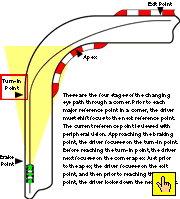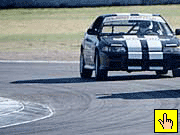Article Topics:
- Overview
- Intro to Racing
- Driving Technique
- Practice Sessions
- Driver’s Gear
- Vehicle Safety
- Handling
- Brakes
- Power
- Tools
TurnFast
recommends
these books:
Articles about Driving Techniques
Visual Field
One of the first things you were probably taught when learning to drive, was the simple principle of "look where you want to go." You were told, "don't look at on coming traffic, look at the cars in your lane in front of you." "Don't stare at the dividing lines, look at the road between them." "Don't look at the wall beside you, look at the lane in front of you." All sound, practical advice, and the same goes for racing.
If you've played, or even watched, just about any sport, you'll notice that the player is constantly looking forward, and not at what he's doing. In basketball, soccer, or hockey a player does not watch himself handle the ball or puck. Rather, he looks down the playing field at where he wants to go or pass. The player’s field of vision is not the few feet in front of him, but the whole field before him and beside him. The more of the field area the player can see and keep track of, the greater are his abilities to avoid opponents, plan a path through the field, and anticipate the movements of others.
The distance and amount of territory the player can keep track of is called his visual field. This requires the combination of two distinct skills. First, the player must look farther ahead than his immediate surroundings. He has to look where he wants to be, not where he is. Second, even though the human eye has a narrow field of focus (only a small portion of what the eye sees is in focus), the player must be able to distinguish activities in those areas that are not currently in focus.
These skills are critical to race driving as well. It should be apparent how they would apply to road full of cars driving for position, but they are equally important for a single car to navigate an empty track at maximum possible speed.
There is a tendency by inexperienced drivers to focus with a tunnel vision right in front of the car. It's a natural reaction. The amount of information the driver is thinking about can be overwhelming, and it is easy to become visually fixated on what is happening right in front of the car. Looking farther ahead requires taking in even more input. At first, it can be very difficult, but as the driver develops shifting, braking, and traction sampling skills into “second nature” habits, he can spend more conscious time expanding his visual field. An every day example of these skills at work can be drawn from the scenario of trying to walk faster than everyone else through a crowded sidewalk. Think of how you do this. Whether you're conscious of it or not, your brain tries to anticipate the movements of those in front of you. By gauging the rhythm and timing of your speed along with the speed and position of others on the sidewalk, your brain calculates when and where "openings" should appear that you can walk through. In order to make these calculations in time to be useful, you must look a certain distance ahead of where you are. The faster you want to go, the farther ahead you need to look. If you were to look at the ground, or only a couple feet in front of you, you would frequently bump into people. You achieve a certain level of fluid movement through the crowd by looking ahead and anticipating your environment’s changing conditions, while keeping tabs on your immediate surroundings through peripheral vision. Your body responds automatically by adjusting speed, and your side to side position as you “dodge” the people around you.
This same technique applies to driving on the track. A driver cannot be focused on where he is on the track. He has to be focused on where he wants to be next on the track. To drive the smoothest and fastest line through a corner, or a series of corners, your brain must get input from far enough down the track to calculate the smoothest lines, and anticipate the amount of steering and pedal input to use.
Driving through a corner consists of four phases, and requires that the driver be looking ahead at least one, if not two, phases at a time. The first phase is the braking zone before the turn. The second is the turn-in, the third is the apex, and the fourth is the exit. If the driver is focused only on the current phase where the car is, he will not be driving smoothly or as fast as is possible through the corner. Each phase will seem like a surprise and will be driven as a jerky sequence of four lines rather than as one fluid path.
To describe the use of an expanded visual field through the corner sequence, we'll describe a typical turn after a long straight. As you approach a corner, your focal point will be the braking reference point. A few car lengths before you reach the braking point, your eyes must focus on the turn-in point. From your peripheral vision, you will notice the braking reference point and apply the brakes. Your eyes are still focused on the turn-in point, and as you approach and get within a few car lengths, your eyes must now look to the corner apex. Keeping the eyes focused on the apex reference point, use your peripheral vision to notice the turn-in reference point and begin the turn-in. Now, as you are approaching the apex, stay focused on the reference point until a few car lengths away, where you will once again shift focus to the next point which is the exit reference point. You will drive through the apex looking at the exit point, not the apex marker. As you approach the exit point, your focus should now shift to looking down the straight, and you will use your peripheral vision again to drive out to the actual exit point as you reach it.
In some situations such as tight chicanes or esses, you may need to be looking through several corner reference points, and driving through them almost entirely with your peripheral vision.
Using your peripheral vision while also focusing in the center of your vision takes some practice--especially at the speeds involved of race driving. If you have already been track driving for a while, at first, this technique may slow you down due to the uncertainty of using your peripheral vision. However, once you get used to it, you will notice that you'll hit your reference points more consistently, and you'll carry a couple more miles per hour through turns you thought you were already maxing out. Developing these skills can takes a few weekends on the track. However, stick to it. Develop the skill first, then bring up your speed. In the end you'll go much faster.
To practice looking ahead, make sure that you are looking through the center of the height of the front windshield. Several school instructors will even suggest that you put a thin tape line on the windshield as a reminder to be looking above it farther down the track until you fully develop this as a habit. These skills can also be practiced during street driving. Around street corners or on windy roads, practice keeping your focal point well ahead of where you are driving, and "seeing" with your peripheral vision.
Read Next Article (Reference Points)

1 - As you approach the braking zone and turn-in point, focus on the turn-in reference point.
2 - A few car lengths from the turn-in point, shift your focus to the corner apex. Use your peripheral vision to keep track of the turn-in point and initiate your turn.
3 - As you approach the apex, shift your focus to the corner exit point. Drive through the apex using your peripheral vision.
4 - Finally, as you near the corner exit point, change your focus to look down the straight or the next turn if it is close.

In this photo, note that the driver is looking through the side window at the apex marker, and not immediately in front of the car.

In this photo, note the position of the driver's head in relation to the car's position. The car is not yet reached the apex, but the driver is looking past the apex marker to the corner exit point of the turn. Also, you can see a shadow of another car in front of this one. Still, the driver of the black car is not looking at the car in front of him, but rather at the point on the track he wants to be at.
